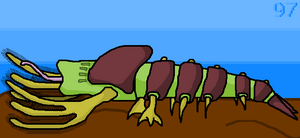| Buryworm | |||
|---|---|---|---|

| |||
| General Information | |||
| Classification | Dipnoivermis eokritophysis | ||
| Homeworld | Sagan IV | ||
| Environment | Bone River | ||
| Intelligence | Non-Sapient | ||
| Biochemistry | Carbon-based lifeform | ||
| Biological Information | |||
| Average Length | 90cm | ||
| Locomotion | Crawling on substrate | ||
| Feeding Behavior | Filter Feeder | ||
| Cladogramatical Information | |||
| Cultural Information | |||
| Organization | Solitary | ||
| Scientific Taxonomy | |||
| Planet | Sagan IV | ||
| Kingdom | Binucleozoa | ||
| Phylum | Sagavermes | ||
| Genus | Dipnoivermis | ||
| Species | eokritophysis | ||
| Other Information | |||
| Status | Extinct | ||
| Creator | Somarinoa | ||
The buryworm evolved from the filterworm, and despite living in direct competition, both species are able to survive. In times of low food intake due to this competition or in times of other stresses such as low water conditions, the buryworm will enter a state of estivation by burying themselves in the mud of the bottom and creating a strange, mucousy seal over its body, called a tomb. This becomes watertight and once complete, the buryworm's metabolism will slow down to 1/70th of its regular rate, allowing these creatures to successfully 'hibernate' for many years, if need be. To obtain the oxygen required for this tomb to allow them to breathe successfully, they will only bury themselves against the shoreline of the water, where the mud is still very wet and malleable yet more likely to be filled with the necessary oxygen.
Because of this process, they could easily be 'baked' into the mud, and only emerge once the area is again drenched in water, but if the waters are normally wet when they enter their tomb (such as when food sources become too low to support two filterers in an area as opposed to the water evaporating), they will instead emerge once every summer to attempt to feed. Although they are at such a drop in metabolism, their brains are set up to know the difference in whether the surrounding area is wet or not, to determine whether or not they will awaken and emerge.
When entombed, it folds its back sets of legs and its tail against its body to prevent them from piercing the small watertight structure, but once they are awakened they will puncture the tomb with their sharp hook-legs, and proceed to work their way out like this over a few hours. Eggs may also survive droughts as they are naturally able to dehydrate themselves, becoming only a tenth of their original, fully-hydrated size. These dehydrated eggs are known as tuns. However, hatched larvae are less likely to survive a drought, as they are not very successful at creating the tombs of the adults and have also lost their egg covering, which acts as a bubble similar to the adults' tomb.
Their tail has adapted to better allow their backwards-style of burrowing themselves, while at the same time their "dorsal spines" have become blunt and more rounded to help prevent actually puncturing their own tombs during hibernation. Also, their filtering fingers have lengthened to allow them to keep eating while burrowed if need be. However, their markings remain similar to their ancestors'.